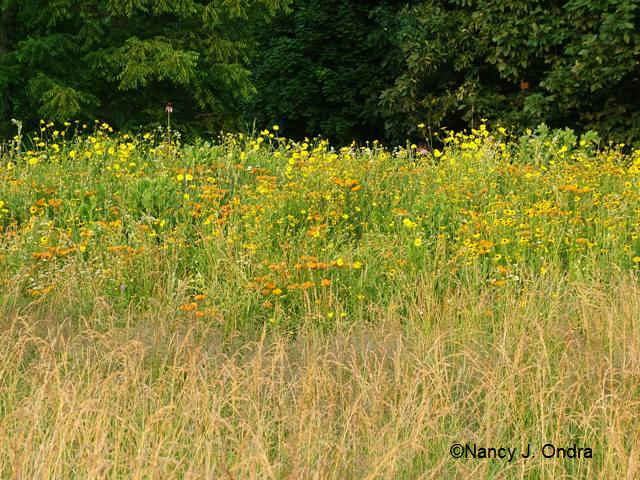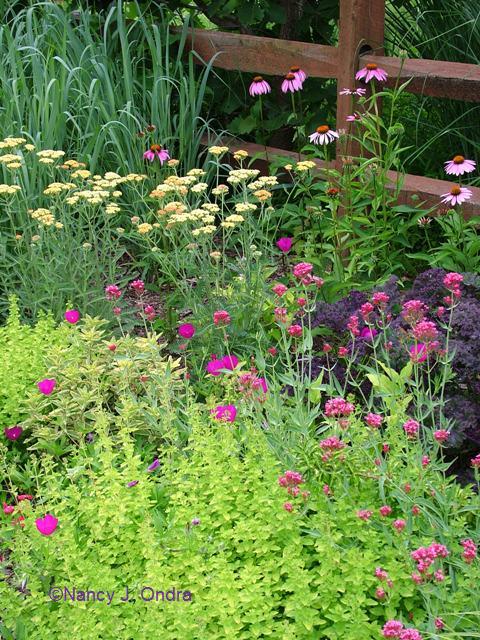When the concept of xeriscaping first entered my consciousness back in the late ’80s, it didn’t appear to have much to do with my own garden. I live in southeastern Pennsylvania, after all, where we get about 40 inches of rainfall a year. Sure, we have dry spells, and even longer rainless periods that can qualify as drought, but for the most part, we’re pretty lucky. I figured that gravel and cacti were okay for folks out west but hardly appropriate for our greener mid-Atlantic landscapes. Gradually, though, I began to realize that the principles behind that seemingly irrelevant concept really were applicable even here.
Cutting down on unnecessary lawn area? Well, I wouldn’t water my grass in any case, but I’m all for getting rid of turf wherever I can for other maintenance reasons. Soil improvement and mulching? Sure, I do that anyway. Irrigating efficiently? Watering is boring, but if I have to do it, you can bet I’m going to do my best to get that water right where it’s needed, only when it’s needed.
 So, much of that seemed simply like common sense. But one principle that has changed the way I garden – particularly in my current, rather large space – is the idea of grouping plants into zones based on their water needs. Those that need the most frequent watering stay closest to the water source and those that need little or no watering are placed at the farthest reaches of the property, with the occasional-watering plantings in between. Here, I pretty much limit my container plantings to the space right around the barn, where I can dump the water from my alpacas’ buckets into them before giving the boys a fresh, cool drink, and a small area out back, where I raise seedlings and cuttings. Any spaces beyond the reach of one hose length on the other side of my house, such as the two plantings pictured above, qualify as no-water zones. And in between, I use the hose for spot-watering as little as possible. So in many respects, I guess I could say that I have a xeriscape garden, even though I didn’t deliberately set out to create one. I’m just trying to make my life easier.
So, much of that seemed simply like common sense. But one principle that has changed the way I garden – particularly in my current, rather large space – is the idea of grouping plants into zones based on their water needs. Those that need the most frequent watering stay closest to the water source and those that need little or no watering are placed at the farthest reaches of the property, with the occasional-watering plantings in between. Here, I pretty much limit my container plantings to the space right around the barn, where I can dump the water from my alpacas’ buckets into them before giving the boys a fresh, cool drink, and a small area out back, where I raise seedlings and cuttings. Any spaces beyond the reach of one hose length on the other side of my house, such as the two plantings pictured above, qualify as no-water zones. And in between, I use the hose for spot-watering as little as possible. So in many respects, I guess I could say that I have a xeriscape garden, even though I didn’t deliberately set out to create one. I’m just trying to make my life easier.
 There’s another water-related movement gaining attention over the last few years that’s had an even more definite impact on my planning and planting: stormwater management. That used to the bailiwick of township officials and land-use planners, but now, our local watershed-protection groups, nature clubs, and other environmental organizations are sponsoring programs to show us homeowners how we can keep whatever rain that we get on our own properties as much as possible. Turns out that receiving plenty of rain can be just as challenging as nearly no rain, as over-development of the land allows the water to run off into creeks and streams before it can soak into the ground, which in turn increases flooding problems when waterways fill more quickly than they can handle. So now, we’re learning how to create features like rain gardens and green roofs, and discovering yet more reasons to reduce lawn areas in favor of mixed plantings and meadows.
There’s another water-related movement gaining attention over the last few years that’s had an even more definite impact on my planning and planting: stormwater management. That used to the bailiwick of township officials and land-use planners, but now, our local watershed-protection groups, nature clubs, and other environmental organizations are sponsoring programs to show us homeowners how we can keep whatever rain that we get on our own properties as much as possible. Turns out that receiving plenty of rain can be just as challenging as nearly no rain, as over-development of the land allows the water to run off into creeks and streams before it can soak into the ground, which in turn increases flooding problems when waterways fill more quickly than they can handle. So now, we’re learning how to create features like rain gardens and green roofs, and discovering yet more reasons to reduce lawn areas in favor of mixed plantings and meadows.
No matter where we live, then, it’s obvious that water is a big issue for all of us gardeners. So, let’s hear your stories about how you deal with water-related issues in your own yards.
- Have your gardening practices changed over the years as you’ve gotten more aware of rainfall patterns in your own area?
- Have your plant choices changed to reduce your watering chores? Or do you have the opposite problem: trying to find plants that can adapt to permanently or seasonally soggy spots without rotting?
- What steps are you taking to collect or retain rainwater in your outdoor space? Do you have rain barrels? Have you created a rain garden? Or are you regrading slopes into flatter terraces, or planting them to cut down on runoff? It all helps!
If you’re new to the GGW Garden Bloggers Design Workshop, here’s how it works: Write a post on anything related to water-related gardening issues on your own blog and give us the link below, or simply leave a comment if you don’t want to do a separate post. If you’ve written about the topic in the past, those links are equally welcome; it’s not necessary to create a new post to participate.
At the end of the month, I’ll gather all of the links into one summary post for easy reference. If you’re interested in checking out previous Garden Bloggers Design Workshops, you can find them here:
 Paths and Walkways
Paths and Walkways
Fences and Walls
Arbors and Pergolas
Color in the Garden
Container Plantings
Front-Yard Gardens
Stone in the Garden
Decks, Porches, and Patios
Garden Whimsy
Trellises and Screens
Water in the Garden
Sheds and Outbuildings
Incorporating Edibles
Kids in the Garden
Labeling and Record-Keeping
Pets in the Garden
Wildlife in the Garden
Don’t forget that you’re all welcome to go back and add links to these older posts at any time.
A final note: Our July topic will be designing with bulbs: both hardy and tender kinds. That gives you plenty of advance notice to take pictures of your spring bulb displays and plan ahead for summer, too.

